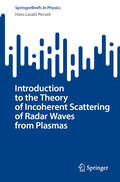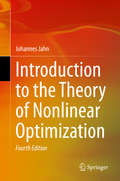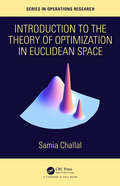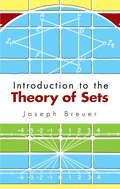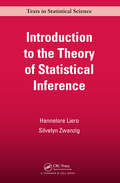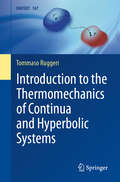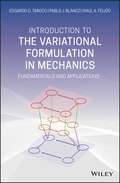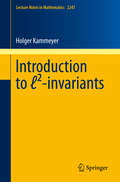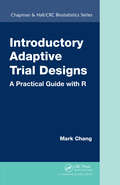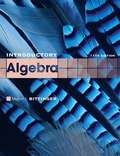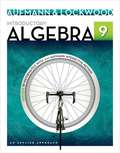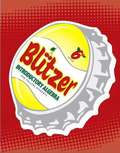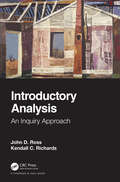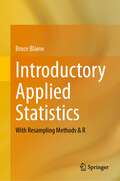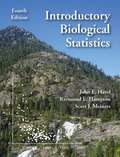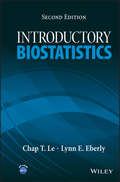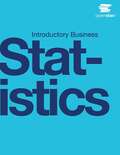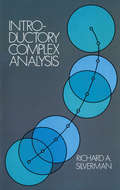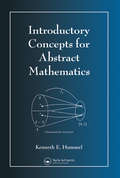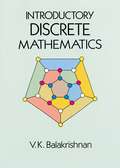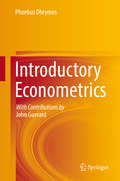- Table View
- List View
Introduction to the Theory of Incoherent Scattering of Radar Waves from Plasmas (SpringerBriefs in Physics)
by Hans László PécseliThis book introduces the theory behind the incoherent scattering of electromagnetic waves (radar waves) by free electrons—a key technique for studying critical parameters of the Earth&’s ionosphere. Starting with scattering by statistically independent electrons, including magnetized cases, the book progressively develops a comprehensive model. This framework is extended to include &‘dressed particles&’, accounting for long-range Coulomb interactions between charged particles. A consistent approach to incorporating particle collisions is presented, with an example of charge exchange interactions for illustration. Appendices provide essential background material, ensuring the content is accessible to readers. Based on lectures delivered at the University of Tromsø, Norway, this book is designed for Masters and PhD students. It assumes a basic understanding of electromagnetism and plasma physics, including plasma waves and electrostatic phenomena. Familiarity with kinetic plasma theory and the collisionless Vlasov equation is beneficial but not mandatory.
Introduction to the Theory of Nonlinear Optimization
by Johannes JahnThis book serves as an introductory text to optimization theory in normed spaces and covers all areas of nonlinear optimization. It presents fundamentals with particular emphasis on the application to problems in the calculus of variations, approximation and optimal control theory. The reader is expected to have a basic knowledge of linear functional analysis.
Introduction to the Theory of Optimization in Euclidean Space (Chapman & Hall/CRC Series in Operations Research)
by Samia ChallalIntroduction to the Theory of Optimization in Euclidean Space is intended to provide students with a robust introduction to optimization in Euclidean space, demonstrating the theoretical aspects of the subject whilst also providing clear proofs and applications. Students are taken progressively through the development of the proofs, where they have the occasion to practice tools of differentiation (Chain rule, Taylor formula) for functions of several variables in abstract situations. Throughout this book, students will learn the necessity of referring to important results established in advanced Algebra and Analysis courses. Features Rigorous and practical, offering proofs and applications of theorems Suitable as a textbook for advanced undergraduate students on mathematics or economics courses, or as reference for graduate-level readers Introduces complex principles in a clear, illustrative fashion
Introduction to the Theory of Sets (Dover Books on Mathematics)
by Joseph Breuer Howard F. FehrSet theory permeates much of contemporary mathematical thought. This text for undergraduates offers a natural introduction, developing the subject through observations of the physical world. Its progressive development leads from concrete finite sets to cardinal numbers, infinite cardinals, and ordinals.Although set theory begins in the intuitive and the concrete, it ascends to a very high degree of abstraction. All that is necessary to its grasp, declares author Joseph Breuer, is patience. Breuer illustrates the grounding of finite sets in arithmetic, permutations, and combinations, which provides the terminology and symbolism for further study. Discussions of general theory lead to a study of ordered sets, concluding with a look at the paradoxes of set theory and the nature of formalism and intuitionalism. Answers to exercises incorporated throughout the text appear at the end, along with an appendix featuring glossaries and other helpful information.
Introduction to the Theory of Statistical Inference (Chapman & Hall/CRC Texts in Statistical Science)
by Hannelore Liero Silvelyn ZwanzigBased on the authors' lecture notes, this text presents concise yet complete coverage of statistical inference theory, focusing on the fundamental classical principles. Unlike related textbooks, it combines the theoretical basis of statistical inference with a useful applied toolbox that includes linear models. Suitable for a second semester undergraduate course on statistical inference, the text offers proofs to support the mathematics and does not require any use of measure theory. It illustrates core concepts using cartoons and provides solutions to all examples and problems.
Introduction to the Thermomechanics of Continua and Hyperbolic Systems (UNITEXT #167)
by Tommaso RuggeriThe primary aim of this book is to present a unified treatment of the thermomechanics of continua using the axiomatic approach typical of rational mechanics. While many books on continuum mechanics focus on specific types of continuous bodies, such as deformable solid bodies or fluids, this book adopts a general perspective. It presents the mathematical structure of balance laws and constitutive equations as a cohesive whole, with special attention given to the modern theory of constitutive equations. Notable principles such as the principle of material indifference and the contemporary interpretation of the principle of entropy are emphasized. This book will be beneficial not only to engineering students but also to students from other scientific disciplines where aspects of continuum mechanics are studied. It provides an opportunity to view traditionally distinct topics in a broader, interconnected context. To ensure self-consistency, the first part of the book addresses issues related to linear algebra, with a particular focus on linear operators within finite-dimensional vector spaces. The book then offers a detailed exploration of finite deformations of continua, followed by an overview of kinematics. It characterizes the various forces that can exist in a continuum, introduces the stress tensor, and presents the balance laws in both Eulerian and Lagrangian forms. Next, the modern theory of constitutive equations is defined, emphasizing the role of the general principles of material indifference and entropy as criteria for selecting physically acceptable classes of constitutive equations. The resulting field equations are specialized for various cases, including thermoelasticity, Eulerian fluids, Fourier-Navier‒Stokes fluids, and rigid heat conductors. In the final part of the book, partial differential equations in continuum mechanics are discussed, with particular attention given to hyperbolic systems. The method of characteristics is introduced in both linear and nonlinear cases, and the need to expand the class of solutions by introducing weak solutions is discussed, with shock waves being a significant case. As an illustrative example of a weak solution, the Riemann problem is presented for the fluid dynamic model of vehicular traffic, where cars are initially stopped at a red light and then start moving when the light turns green.
Introduction to the Variational Formulation in Mechanics: Fundamentals and Applications
by Edgardo O. Taroco Pablo J. Blanco Raúl A. FeijóoIntroduces readers to the fundamentals and applications of variational formulations in mechanics Nearly 40 years in the making, this book provides students with the foundation material of mechanics using a variational tapestry. It is centered around the variational structure underlying the Method of Virtual Power (MVP). The variational approach to the modeling of physical systems is the preferred approach to address complex mathematical modeling of both continuum and discrete media. This book provides a unified theoretical framework for the construction of a wide range of multiscale models. Introduction to the Variational Formulation in Mechanics: Fundamentals and Applications enables readers to develop, on top of solid mathematical (variational) bases, and following clear and precise systematic steps, several models of physical systems, including problems involving multiple scales. It covers: Vector and Tensor Algebra; Vector and Tensor Analysis; Mechanics of Continua; Hyperelastic Materials; Materials Exhibiting Creep; Materials Exhibiting Plasticity; Bending of Beams; Torsion of Bars; Plates and Shells; Heat Transfer; Incompressible Fluid Flow; Multiscale Modeling; and more. A self-contained reader-friendly approach to the variational formulation in the mechanics Examines development of advanced variational formulations in different areas within the field of mechanics using rather simple arguments and explanations Illustrates application of the variational modeling to address hot topics such as the multiscale modeling of complex material behavior Presentation of the Method of Virtual Power as a systematic tool to construct mathematical models of physical systems gives readers a fundamental asset towards the architecture of even more complex (or open) problems Introduction to the Variational Formulation in Mechanics: Fundamentals and Applications is a ideal book for advanced courses in engineering and mathematics, and an excellent resource for researchers in engineering, computational modeling, and scientific computing.
Introduction to ℓ²-invariants (Lecture Notes in Mathematics #2247)
by Holger KammeyerThis book introduces the reader to the most important concepts and problems in the field of ℓ²-invariants. After some foundational material on group von Neumann algebras, ℓ²-Betti numbers are defined and their use is illustrated by several examples. The text continues with Atiyah's question on possible values of ℓ²-Betti numbers and the relation to Kaplansky's zero divisor conjecture. The general definition of ℓ²-Betti numbers allows for applications in group theory. A whole chapter is dedicated to Lück's approximation theorem and its generalizations. The final chapter deals with ℓ²-torsion, twisted variants and the conjectures relating them to torsion growth in homology. The text provides a self-contained treatment that constructs the required specialized concepts from scratch. It comes with numerous exercises and examples, so that both graduate students and researchers will find it useful for self-study or as a basis for an advanced lecture course.
Introductory Adaptive Trial Designs: A Practical Guide with R
by Mark ChangAll the Essentials to Start Using Adaptive Designs in No TimeCompared to traditional clinical trial designs, adaptive designs often lead to increased success rates in drug development at reduced costs and time. Introductory Adaptive Trial Designs: A Practical Guide with R motivates newcomers to quickly and easily grasp the essence of adaptive desig
Introductory Algebra An Applied Approach 9th Edition
by Richard N. Aufmann Joanne S. LockwoodAs in previous editions, the focus in INTRODUCTORY ALGEBRA remains on the Aufmann Interactive Method (AIM). Students are encouraged to be active participants in the classroom and in their own studies as they work through the examples. Student engagement is crucial to success.
Introductory Algebra Student Workbook, Vol. 2 (Fifth Edition)
by Scottsdale Community College Mathematics DepartmentIntroductory Algebra Student Workbook V2 is designed to lead students through Introductory Algebra
Introductory Algebra for College Students (Sixth Edition)
by Robert BlitzerThis book provides comprehensive, in-depth coverage of the topics required in a one-term course in beginning or introductory algebra.
Introductory Analysis: An Inquiry Approach
by John D. Ross Kendall C. RichardsIntroductory Analysis: An Inquiry Approach aims to provide a self-contained, inquiry-oriented approach to undergraduate-level real analysis. The presentation of the material in the book is intended to be "inquiry-oriented'" in that as each major topic is discussed, details of the proofs are left to the student in a way that encourages an active approach to learning. The book is "self-contained" in two major ways: it includes scaffolding (i.e., brief guiding prompts marked as Key Steps in the Proof) for many of the theorems. Second, it includes preliminary material that introduces students to the fundamental framework of logical reasoning and proof-writing techniques. Students will be able to use the guiding prompts (and refer to the preliminary work) to develop their proof-writing skills. Features Structured in such a way that approximately one week of class can be devoted to each chapter Suitable as a primary text for undergraduates, or as a supplementary text for some postgraduate courses Strikes a unique balance between enquiry-based learning and more traditional approaches to teaching
Introductory Applied Statistics: With Resampling Methods & R
by Bruce BlaineThis book offers an introduction to applied statistics through data analysis, integrating statistical computing methods. It covers robust and non-robust descriptive statistics used in each of four bivariate statistical models that are commonly used in research: ANOVA, proportions, regression, and logistic. The text teaches statistical inference principles using resampling methods (such as randomization and bootstrapping), covering methods for hypothesis testing and parameter estimation. These methods are applied to each statistical model introduced in preceding chapters.Data analytic examples are used to teach statistical concepts throughout, and students are introduced to the R packages and functions required for basic data analysis in each of the four models. The text also includes introductory guidance to the fundamentals of data wrangling, as well as examples of write-ups so that students can learn how to communicate findings. Each chapter includes problems for practice or assessment. Supplemental instructional videos are also available as an additional aid to instructors, or as a general resource to students. This book is intended for an introductory or basic statistics course with an applied focus, or an introductory analytics course, at the undergraduate level in a two-year or four-year institution. This can be used for students with a variety of disciplinary backgrounds, from business, to the social sciences, to medicine. No sophisticated mathematical background is required.
Introductory Biological Statistics
by Scott J. Meiners Raymond E. Hampton John E. HavelCourses such as statistics, which develop quantitative analytical skills, remain important preparation for careers in the sciences and graduate school. The book supports teaching a one-semester-long course in statistics with a focus on biological examples and applications. Students need not have any prior exposure to probability and statistics, although college algebra is recommended. The book has added concept checks in all of the chapters, as well as more definition boxes and examples. A number of substantive changes has been made in this new edition. The exercises in each chapter have now been sorted into two groups: practice exercises (with solutions in appendix B) and homework exercises (solutions available only to instructors).
Introductory Biological Statistics (3rd Edition)
by Raymond E. Hampton John E. HavelHampton and Havel's clear, approachable text has guided a generation of biology students through their first foray into statistics. The third edition continues to provide a thorough grounding in all essential methods of descriptive and inferential statistics, ideal for any student seeking a career in experimental sciences. Each chapter has been carefully updated and restructured to enhance understanding, better bridge the gaps between topics, and create a pragmatic approach to learning the many uses of statistics in biology. The authors complement their descriptions with an abundance of examples and exercises that illustrate how to choose and apply statistical procedures and interpret their results in real-world scenarios, allowing students to develop and test their understanding while building their confidence with the material. The third edition explores changing standards of technology and includes new boxed examples written by experts on computer-intensive resampling methods, multivariate analysis, and meta-analysis. Use of Minitab's outstanding statistical software (now included on the CD accompanying the book) is incorporated through the text.
Introductory Biostatistics
by Chap T. Le Lynn E. EberlyPraise for the First Edition "Students from health, medical, pharmacy, and nursing will find...Introductory Biostatistics extremely useful. Difficult biostatistical concepts are made easier by simple and careful explanations..." - Journal of Statistical Computation and Simulation Maintaining the same accessible and hands-on presentation, Introductory Biostatistics, Second Edition continues to provide an organized introduction to basic statistical concepts commonly applied in research across the health sciences. With plenty of real-world examples, the new edition provides a practical, modern approach to the statistical topics found in the biomedical and public health fields. Beginning with an overview of descriptive statistics in the health sciences, the book delivers topical coverage of probability models, parameter estimation, and hypothesis testing. Subsequently, the book focuses on more advanced topics with coverage of regression analysis, logistic regression, methods for count data, analysis of survival data, and designs for clinical trials. Featuring a thorough update, Introductory Biostatistics, Second Edition includes: A new chapter on the use of higher order Analysis of Variance (ANOVA) in factorial and block designs A new chapter on testing and inference methods for repeatedly measured outcomes including continuous, binary, and count outcomes R incorporated throughout along with SAS®, allowing readers to replicate results from presented examples with either software Multiple additional exercises, with partial solutions available to aid comprehension of crucial concepts Notes on Computations sections to provide further guidance on the use of software A related website that hosts the large data sets presented throughout the book Introductory Biostatistics, Second Edition is an excellent textbook for upper-undergraduate and graduate students in introductory biostatistics courses. The book is also an ideal reference for applied statisticians working in the fields of public health, nursing, dentistry, and medicine.
Introductory Business Statistics
by Barbara Illowsky Susan Dean Alexander HolmesIntroductory Business Statistics is designed to meet the scope and sequence requirements of the one-semester statistics course for business, economics, and related majors. Core statistical concepts and skills have been augmented with practical business examples, scenarios, and exercises. The result is a meaningful understanding of the discipline, which will serve students in their business careers and real-world experiences.
Introductory Complex Analysis (Dover Books on Mathematics)
by Richard A. SilvermanIntroductory Complex Analysis is a scaled-down version of A. I. Markushevich's masterly three-volume "Theory of Functions of a Complex Variable." Dr. Richard Silverman, the editor and translator of the original, has prepared this shorter version expressly to meet the needs of a one-year graduate or undergraduate course in complex analysis. In his selection and adaptation of the more elementary topics from the original larger work, he was guided by a brief course prepared by Markushevich himself.The book begins with fundamentals, with a definition of complex numbers, their geometric representation, their algebra, powers and roots of complex numbers, set theory as applied to complex analysis, and complex functions and sequences. The notions of proper and improper complex numbers and of infinity are fully and clearly explained, as is stereographic projection. Individual chapters then cover limits and continuity, differentiation of analytic functions, polynomials and rational functions, Mobius transformations with their circle-preserving property, exponentials and logarithms, complex integrals and the Cauchy theorem , complex series and uniform convergence, power series, Laurent series and singular points, the residue theorem and its implications, harmonic functions (a subject too often slighted in first courses in complex analysis), partial fraction expansions, conformal mapping, and analytic continuation.Elementary functions are given a more detailed treatment than is usual for a book at this level. Also, there is an extended discussion of the Schwarz-Christolfel transformation, which is particularly important for applications.There is a great abundance of worked-out examples, and over three hundred problems (some with hints and answers), making this an excellent textbook for classroom use as well as for independent study. A noteworthy feature is the fact that the parentage of this volume makes it possible for the student to pursue various advanced topics in more detail in the three-volume original, without the problem of having to adjust to a new terminology and notation .In this way, IntroductoryComplex Analysis serves as an introduction not only to the whole field of complex analysis, but also to the magnum opus of an important contemporary Russian mathematician.
Introductory Concepts for Abstract Mathematics
by Kenneth E. HummelBeyond calculus, the world of mathematics grows increasingly abstract and places new and challenging demands on those venturing into that realm. As the focus of calculus instruction has become increasingly computational, it leaves many students ill prepared for more advanced work that requires the ability to understand and construct proofs.Introductory Concepts for Abstract Mathematics helps readers bridge that gap. It teaches them to work with abstract ideas and develop a facility with definitions, theorems, and proofs. They learn logical principles, and to justify arguments not by what seems right, but by strict adherence to principles of logic and proven mathematical assertions - and they learn to write clearly in the language of mathematicsThe author achieves these goals through a methodical treatment of set theory, relations and functions, and number systems, from the natural to the real. He introduces topics not usually addressed at this level, including the remarkable concepts of infinite sets and transfinite cardinal numbersIntroductory Concepts for Abstract Mathematics takes readers into the world beyond calculus and ensures their voyage to that world is successful. It imparts a feeling for the beauty of mathematics and its internal harmony, and inspires an eagerness and increased enthusiasm for moving forward in the study of mathematics.
Introductory Discrete Mathematics (Dover Books on Computer Science)
by V. K BalakrishnanThis concise text offers an introduction to discrete mathematics for undergraduate students in computer science and mathematics. Mathematics educators consider it vital that their students be exposed to a course in discrete methods that introduces them to combinatorial mathematics and to algebraic and logical structures focusing on the interplay between computer science and mathematics. The present volume emphasizes combinatorics, graph theory with applications to some stand network optimization problems, and algorithms to solve these problems.Chapters 0-3 cover fundamental operations involving sets and the principle of mathematical induction, and standard combinatorial topics: basic counting principles, permutations, combinations, the inclusion-exclusion principle, generating functions, recurrence relations, and an introduction to the analysis of algorithms. Applications are emphasized wherever possible and more than 200 exercises at the ends of these chapters help students test their grasp of the material.Chapters 4 and 5 survey graphs and digraphs, including their connectedness properties, applications of graph coloring, and more, with stress on applications to coding and other related problems. Two important problems in network optimization - the minimal spanning tree problem and the shortest distance problem - are covered in the last two chapters. A very brief nontechnical exposition of the theory of computational complexity and NP-completeness is outlined in the appendix.
Introductory Econometrics
by Humberto Barreto Frank M. HowlandThis highly accessible and innovative text and accompanying CD-ROM use Excel (R) workbooks powered by Visual Basic macros to teach the core concepts of econometrics without advanced mathematics. It enables students to run Monte Carlo simulations in order to understand the data generating process and sampling distribution. Intelligent repetition of concrete examples effectively conveys the properties of the ordinary least squares (OLS) estimator and the nature of heteroskedasticity and autocorrelation. Coverage includes omitted variables, binary response models, basic time series, and simultaneous equations. The authors teach students how to construct their own real-world data sets drawn from the internet, which they can analyze with Excel (R) or with other econometric software. The Excel add-ins allow students to draw histograms, to compute P-values and robust standard errors, and to construct their own MonteCarlo and bootstrap simulations. For more readers may visit the web site at www. wabash. edu/econometrics.
Introductory Econometrics
by Phoebus DhrymesThis book has taken form over several years as a result of a number of courses taught at the University of Pennsylvania and at Columbia University and a series of lectures I have given at the International Monetary Fund. Indeed, I began writing down my notes systematically during the academic year 1972-1973 while at the University of California, Los Angeles. The diverse character of the audience, as well as my own conception of what an introductory and often terminal acquaintance with formal econometrics ought to encompass, have determined the style and content of this volume. The selection of topics and the level of discourse give sufficient variety so that the book can serve as the basis for several types of courses. As an example, a relatively elementary one-semester course can be based on Chapters one through five, omitting the appendices to these chapters and a few sections in some of the chapters so indicated. This would acquaint the student with the basic theory of the general linear model, some of the prob#65533; lems often encountered in empirical research, and some proposed solutions. For such a course, I should also recommend a brief excursion into Chapter seven (logit and pro bit analysis) in view of the increasing availability of data sets for which this type of analysis is more suitable than that based on the general linear model.
Introductory Econometrics for Finance
by Chris BrooksThis best-selling textbook addresses the need for an introduction to econometrics specifically written for finance students. Key features: · Thoroughly revised and updated, including two new chapters on panel data and limited dependent variable models · Problem-solving approach assumes no prior knowledge of econometrics emphasising intuition rather than formulae, giving students the skills and confidence to estimate and interpret models · Detailed examples and case studies from finance show students how techniques are applied in real research · Sample instructions and output from the popular computer package EViews enable students to implement models themselves and understand how to interpret results · Gives advice on planning and executing a project in empirical finance, preparing students for using econometrics in practice · Covers important modern topics such as time-series forecasting, volatility modelling, switching models and simulation methods · Thoroughly class-tested in leading finance schools
